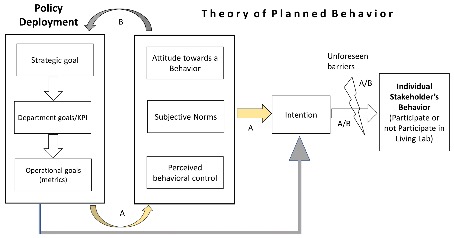A Managerial and Behavioral Approach in Aligning Stakeholder Goals in Sustainable Last Mile Logistics
A Case Study in the Netherlands
Various stakeholders are involved in supply chains: shippers, logistic service providers, hub operators, receivers, last mile carriers, etc.. Implementation of sustainable last mile logistics solutions requires all of them to adapt their processes. Therefore, the first step in setting up successful sustainable last mile logistics is to conduct a stakeholder analysis depicting their interests and drivers and barriers for changing their behavior towards more sustainable last mile logistic concepts. A summary of the stakeholder analysis is reported in this paper.
Context and relevance
Stakeholders play vital roles in the implementation of sustainable last mile logistics solutions. This paper analyzes the goals of the stakeholders in the Heijendaal living lab, a city logistics project that uses two hubs for bundling goods to be delivered to the Heijendaal campus in The Netherlands in order to increase the sustainability and livability of the campus.
Research question
How can the individual (non) participating behavior of various stakeholders be understood for the various stakeholders in the Heijendaal living lab?
Research approach
We conduct a qualitative case study (Heijendaal living lab) and combine
- Policy Deployment as an approach to examine the goals of stakeholders in relation to their roles in the supply chain (shippers, logistic service providers, hub operators, etc.) and within the organization (strategic, tactical, operational level), and
- the Theory of Planned Behavior as an approach to describe to what extent these goals are expected to lead to participation behavior of individual decision makers.
The case study is carried out by conducting in depth interviews with various stakeholders. Stakeholders from most stakeholder groups and within different hierarchical levels were included in order to represent a realistic picture of the stakeholders.
Results
General
A theoretical framework is developed (refer to figure 1) that combines policy deployment (top-down organizational level) and theory of planned behavior (individual choice behavior) to describe (non)participating behavior in sustainable supply. Results indicate that on the one hand, alignment of goals exists between strategic and tactical levels for both suppliers and receivers. However, the alignment of goals between the tactical and operational levels for receivers is missing. Due to this, the realization of the strategic goal of an organization is currently sub-optimal. To give an example: an organization may have a sustainability strategy, but if at the operational level goals on costs or delivery terms are prominent, using a city hub (which may lead to a longer delivery time or additional costs) may be discouraged. On the other hand, some cases of suppliers and receivers show that the sustainable behavior of an organization exists at middle-level management despite the lack of promoting sustainability goals at a strategic level. These “sustainability minded” actors should be empowered to initiate change.
This study identifies the importance of information sharing and collaboration within the supply chain, the leading role of middle-level managers in translating strategic to operational goals, and the stimulation of behavioral factors to increase participation of stakeholders in the living lab.

Figure 1. The theoretical framework adapted from the framework of organizational and behavioral mode choice processes as developed by Bogers (2017).
Impacts on goals living lab
This paper highlighted that, in order to have the desired impact on the goals of the living lab (increased sustainability and livability, at acceptable cost and service levels), alignment between and within stakeholder goals is necessary. It was found that this alignment is not (completely) present yet. However, by conducting this study and interviewing all stakeholders about sustainable last mile logistics in the living lab Heijendaal and in general, the study proved to be an excellent kick starter to initiate the living lab: stakeholders were confronted and promoted to talk and think about sustainability and integrate their business with the lab and towards sustainability.
Conclusions, policy recommendations and directions for future research
There are three main conclusions:
- First, if the sustainability goals of stakeholders are aligned along the supply chain and between the management levels, the more likely the organization will participate in sustainable last mile logistics. On a supply chain level, alignment could be achieved via information sharing and collaboration, requiring the use of the City hub on a tendering process, and intervention of receivers to help suppliers. On an organizational level, middle-level managers could play an important role as boundary spanners by translating strategic goals to operational levels, by influencing cultures at lower levels, and by bringing information and insights to both lower and upper levels.
- Second, influencing individual behavioral factors such as attitude, norms, and control, could lead individuals and organizations to set sustainability goals and to participate in sustainable last mile logistics. Strengthening the behavioral factors may include individual exposure to sustainability, training, and hiring personnel based on their affinity to sustainability.
- Third, coping with unforeseen barriers such as habits and disruption factors could improve the sustainable behavior of an individual and eventually the organization as a whole. If for example, a clear sustainability strategy is in place, effectively deployed to the tactical and operational level, but the operational buyer is unable to enter in the IT system that an order needs to be shipped through the city hub, or due to strong habits chooses the non-hub route, all sustainability efforts become useless. Coping with unforeseen barriers could be done by increasing awareness, such as by adding an IT function that will inform employees of the consequences of their buying behavior, and by making the participation in sustainable last mile logistics part of an individual’s work.
All parties involved in the supply chain are therefore advised to (1) set strategic sustainability goals and translate them via their middle management to the operational level, (2) make their personnel more aware of sustainability and (3) cope with unforeseen barriers . Furthermore, they should share information and collaborate with each other in the supply chain, which probably needs to be pro-actively enforced top-down (4). Receivers, in particular, are advised to require attention to sustainable supply in a tender, for instance through prescribing the use of a city hub (5).
Future research is advised on understanding in more detail how both mechanisms (policy deployment (top-down organizational level) and theory of planned behavior (individual choice behavior)) can be put to work in practice to reach more sustainable supply goals.
